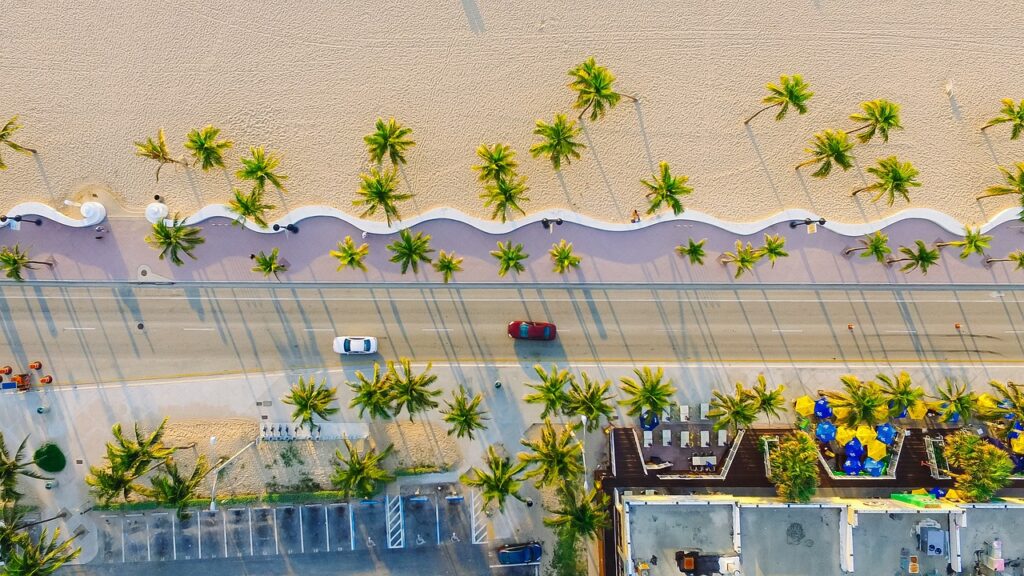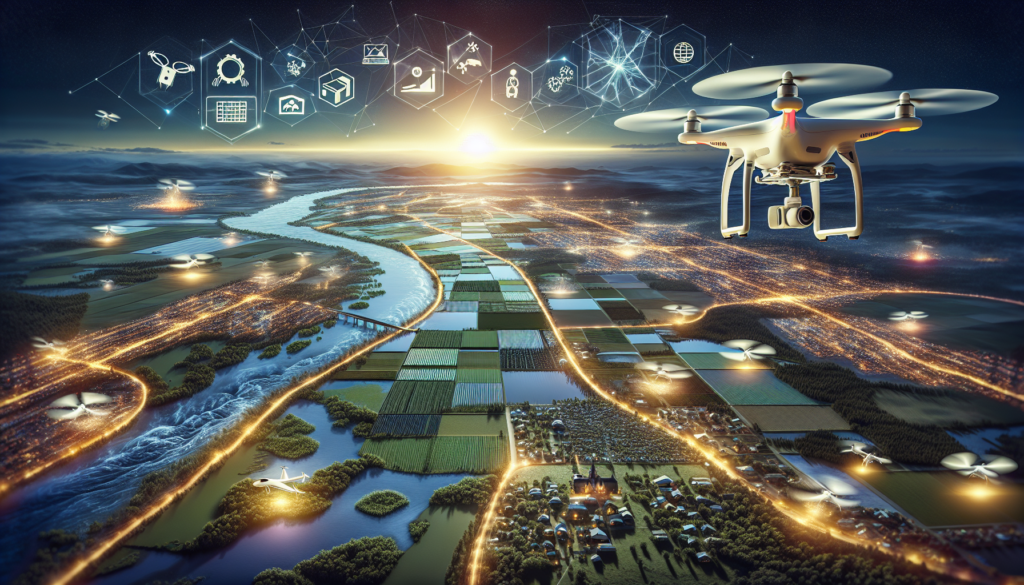In the ever-evolving world of technology, drones have become an indispensable tool, revolutionizing various industries and transforming the way we perceive the possibilities of aerial exploration. As we fast forward to the year 2023, drones have soared to new heights, finding their place in areas ranging from delivery services and agriculture to cinematography and emergency response. These unmanned aerial vehicles have showcased their ability to navigate even the most challenging terrains, offering convenience, efficiency, and novel perspectives. So, let’s embark on a fascinating journey to uncover the multitude of applications and advancements that drones have brought to our lives in this futuristic landscape.
Delivery Services
Food Delivery
In 2023, drones have become a popular method for delivering food to customers. With their ability to navigate quickly and efficiently through traffic, drones can ensure that your meals are delivered to your doorstep in a timely manner. Whether you’re ordering from your favorite restaurant or craving a late-night snack, drone food delivery services are revolutionizing the way we have our meals.
Medicine Delivery
Drones’ role in delivering medicine cannot be underestimated. In remote areas with limited healthcare access or during emergencies, drones can quickly transport essential medications and medical supplies to those in need. This technology has the potential to save lives and improve medical outcomes, especially in situations where time is of the essence.
Package Delivery
With the rise of e-commerce, the demand for efficient package delivery services has increased exponentially. Drones provide a solution to this demand by offering quick and efficient delivery options. Whether it’s delivering a gift to a loved one or receiving a package from an online retailer, drones can navigate through traffic and deliver your items right to your doorstep.
E-commerce
Product Photography
Drones have made product photography more dynamic and appealing. They can capture unique angles and perspectives that traditional photography methods cannot achieve. By using drones, businesses can showcase their products in a visually captivating way, attracting more customers and increasing sales.
Inventory Management
The use of drones in inventory management has proven to be a game-changer for businesses. Drones can easily scan and monitor inventory levels, track movement, and provide real-time data to optimize supply chain operations. This automation helps businesses minimize errors, reduce costs, and streamline their inventory management processes.
Warehouse Monitoring
Drones are increasingly being utilized for warehouse monitoring and security purposes. Equipped with cameras and sensors, drones can patrol warehouses and monitor for any suspicious activities or intrusions. By providing live video feeds and real-time alerts, drones help enhance security measures, prevent theft, and maintain a safe working environment.

Agriculture
Crop Monitoring
Drones are revolutionizing the way farmers monitor their crops. Equipped with imaging sensors, drones can capture high-resolution images of crops, allowing farmers to identify areas that require attention, such as pests, diseases, or irrigation issues. This data enables farmers to take timely and targeted action, improving crop yields and reducing unnecessary costs.
Precision Agriculture
Precision agriculture involves using technology to optimize farming practices. Drones play a crucial role in this field by providing accurate data on soil moisture levels, crop health, and field mapping. This information allows farmers to make informed decisions about fertilization, irrigation, and pesticide use, leading to more sustainable farming practices and increased productivity.
Spraying and Seeding
The traditional methods of spraying and seeding crops can be time-consuming and labor-intensive. Drones equipped with precision spraying systems can efficiently and precisely apply fertilizers, pesticides, and other chemicals to crops. This ensures even distribution, reduces product waste, and minimizes human exposure to harmful substances. Additionally, drones can also be used for aerial seeding, allowing for the efficient planting of crops across vast areas.
Construction and Infrastructure
Surveying and Mapping
Drones have transformed the field of surveying and mapping by providing high-resolution aerial imagery and 3D modeling. They can quickly and accurately survey construction sites, map topographic features, and create detailed digital terrain models. This data helps construction companies plan and execute projects more efficiently, saving time and resources.
Inspections
Drones are increasingly used for inspecting infrastructure such as buildings, bridges, and power lines. With their ability to reach inaccessible or dangerous locations, drones can capture detailed images and videos that enable inspectors to identify potential issues or damage. This proactive approach to inspections improves maintenance practices, enhances safety, and reduces costs associated with manual inspections.
Security and Surveillance
Drones are powerful tools for enhancing security and surveillance in construction sites, infrastructure projects, and public spaces. Equipped with advanced cameras and sensors, drones can monitor activities, identify potential security threats, and provide real-time video feeds to security personnel. This proactive surveillance helps prevent theft, trespassing, and other criminal activities.

Media and Entertainment
Filmmaking
Drones have revolutionized the film industry, making aerial shots more accessible and cost-effective. With their manoeuvrability and ability to capture stunning cinematic footage, drones offer filmmakers creative possibilities that were previously only achievable with expensive equipment. Drones have added a new level of visual storytelling to films, commercials, and music videos, enriching the overall viewing experience.
Event Coverage
From sporting events to music festivals, drones have become an integral part of event coverage. They capture dynamic aerial footage that adds a unique perspective to the coverage, immersing viewers in the event atmosphere. Drones enable event organizers and media outlets to provide comprehensive and engaging coverage, allowing audiences to experience events like never before.
Advertising and Marketing
Drones are now being used extensively for advertising and marketing campaigns. They can capture attention-grabbing aerial shots of products, events, or locations, creating visually stunning and memorable content. Moreover, drones offer businesses the opportunity to showcase their offerings from unique angles, captivating audiences and driving brand awareness.
Search and Rescue
Disaster Assessment
During natural disasters such as earthquakes or hurricanes, drones can play a critical role in assessing damage and evaluating potential risks. Equipped with thermal imaging cameras and sensors, drones can identify survivors, locate hazards, and gather important data that aids in disaster response planning and coordination.
Missing Person Search
Drones have become invaluable tools in search and rescue operations. When people go missing in remote or inaccessible areas, drones can cover vast terrains quickly and efficiently, increasing the chances of finding missing individuals. Equipped with infrared cameras and GPS tracking, drones help search teams navigate challenging environments and locate individuals in need of assistance.
Emergency Supply Delivery
In emergency situations where conventional transportation methods are hindered, drones can provide a lifeline by delivering essential supplies such as food, water, and medical aid. Drones are capable of navigating disaster-stricken areas, bypassing traffic and logistical obstacles to reach those in need, ensuring timely support during critical situations.

Environmental Monitoring
Wildlife Conservation
Drones are emerging as powerful tools in wildlife conservation efforts. By conducting aerial surveys and utilizing various imaging technologies, drones can monitor animal populations, track migration patterns, and detect poaching activities. This data helps conservationists and wildlife authorities implement effective conservation strategies and protect endangered species.
Forest Fire Detection
Drones equipped with thermal and multispectral sensors can detect forest fires in their early stages, enabling rapid response and containment efforts. By surveying vast areas from the air, drones can identify hotspots and provide real-time information to firefighting teams, helping them mitigate the spread of fires and safeguard ecosystems.
Air and Water Quality Assessment
Drones are proving to be effective in monitoring air and water quality. Equipped with specialized sensors, they can collect samples and measure pollution levels in hard-to-reach areas. This data is crucial for environmental agencies and researchers to assess the impact of human activities, mitigate pollution, and develop strategies for environmental protection.
Medical Assistance
Emergency Response
Drones are revolutionizing emergency response services by providing swift and efficient assistance. In critical situations such as cardiac arrests or accidents, drones equipped with medical supplies and defibrillators can reach patients faster than traditional emergency vehicles. These drones can stabilize patients, provide life-saving interventions, and bridge the gap between emergency calls and professional medical help.
Blood and Organ Transportation
Transporting blood and organs for emergency surgeries is time-sensitive and requires utmost precision. Drones offer a reliable and fast means of transportation, especially in rural or remote areas where access to medical facilities is limited. By delivering essential medical supplies and organs, drones have the potential to save lives and improve healthcare outcomes.
Remote Healthcare
Drones are transforming the delivery of healthcare services in remote areas. With telemedicine capabilities, drones can transport medical professionals virtually to patients, enabling consultations and remote diagnosis. This technology helps bridge the gap in healthcare access, particularly in underserved regions, and allows for timely medical interventions and treatments.

Public Safety
Crime Prevention
Drones are increasingly being utilized by law enforcement agencies to prevent and deter crime. Equipped with high-resolution cameras and real-time video streaming capabilities, drones assist in monitoring high-crime areas, enhancing surveillance efforts, and gathering evidence for criminal investigations. This proactive approach to crime prevention helps enhance public safety and reduce crime rates.
Traffic Management
Traffic congestion is a major challenge in urban areas. Drones can help manage traffic by providing real-time monitoring and data collection on traffic flow, road conditions, and accidents. This information enables authorities to optimize traffic management strategies, improve road safety, and minimize traffic congestion, resulting in smoother and more efficient transportation systems.
Crowd Monitoring
During large public events, ensuring crowd safety is crucial. Drones provide a bird’s-eye view that helps authorities monitor crowd movements, identify potential safety risks, and respond to emergencies swiftly. By providing real-time situational awareness, drones assist in maintaining public safety, preventing stampedes, and ensuring the well-being of event attendees.
Research and Exploration
Scientific Studies
Drones are increasingly being used for scientific research purposes, especially in fields such as ecology, geology, and marine biology. Equipped with specialized cameras and sensors, drones facilitate data collection in remote and inaccessible areas, enabling researchers to study ecosystems, monitor wildlife, and gather valuable information for scientific studies.
Archaeological Surveys
Archaeologists are turning to drones for conducting aerial surveys and mapping archaeological sites. Drones capture high-resolution images that help document and analyze ancient structures, landscapes, and artifacts. This technology allows archaeologists to gain new insights into historical sites while minimizing the risk of damage to fragile archaeological remains.
Exploring Inaccessible Areas
Drones have the unique ability to access areas that are otherwise difficult or dangerous for humans to reach. Whether it’s exploring remote caves, surveying rugged terrains, or navigating hazardous environments, drones provide an invaluable tool for exploration and research. This technology opens up new possibilities for discovery and understanding in various fields.


